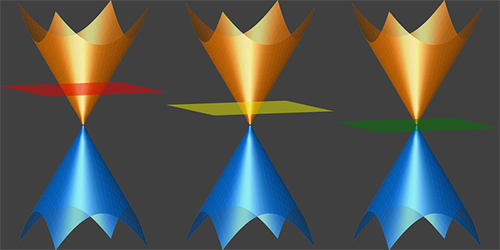A Textbook Dirac Semimetal
Dirac semimetals are exotic quantum materials regarded as three-dimensional analogs of graphene: in such semimetals, as in graphene, the electrons behave as fermions with zero mass, leading to unique optical, magnetic, and transport properties. Only a handful of such systems, however, have been uncovered. A challenge for experimentalists lies in the often complicated electronic band structure of these materials, which makes it hard to disentangle effects due to the zero-mass relativistic electrons from those due to trivial electronic states. Now a team led by David Santos-Cottin of the University of Fribourg in Switzerland has demonstrated that a chalcogenide compound, TlBiSSe, can be synthesized with an extremely clean and tunable band structure that is characteristic of a Dirac semimetal [1]. The result suggests that TlBiSSe might be an ideal material platform for exploring relativistic-electron phenomena in solids, says Santos-Cottin.
The unusual properties of Dirac semimetals are associated with Dirac cones—features in the electronic structure where the full (valence) and empty (conduction) bands are shaped like two halves of a conical surface meeting at a Dirac point. The researchers determined their material’s electronic structure by measuring optical reflectivity and transmission, which probe electronic transitions between the valence and conduction bands. Investigating three samples synthesized with different initial ratios of thallium to bismuth, they found that such ratios controlled the position of the Fermi energy—which dictates the boundary between occupied and unoccupied energy states for electrons. For a 1.5:0.5 ratio, the sample displayed all the expected features of a Dirac semimetal: a small gap, a linear dispersion curve (plotting the relationship between electron energies and momenta), and the emergence of the so-called Landau quantization of the electron energy levels induced by the application of a magnetic field.
–Matteo Rini
Matteo Rini is the Editor of Physics Magazine.
References
- F. Le Mardelé et al., “Evidence for three-dimensional Dirac conical bands in TlBiSSe by optical and magneto-optical spectroscopy,” Phys. Rev. B 107, L241101 (2023).




